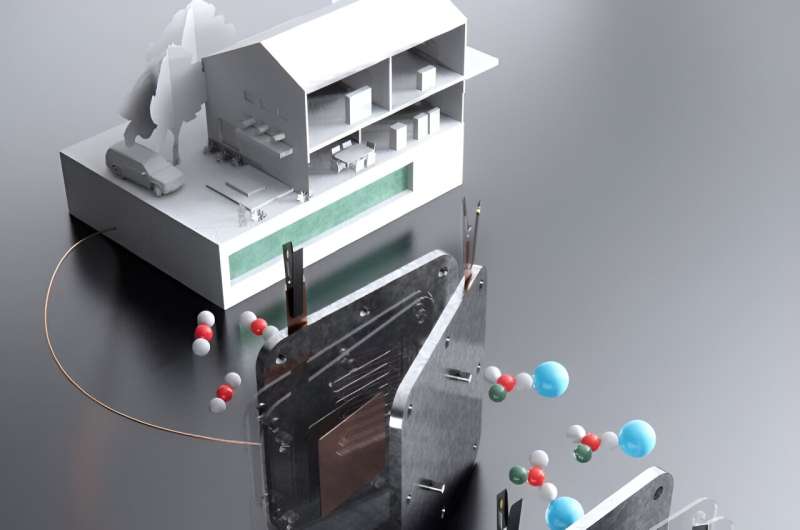December 14, 2023 report
This article has been reviewed according to Science X's editorial process and policies. Editors have highlighted the following attributes while ensuring the content's credibility:
fact-checked
trusted source
proofread
Best of Last Year: The top Tech Xplore articles of 2023

It was a good year for technology research and development, and nothing made the news more often than energy research efforts. Leading the way were efforts surrounding the use and development of solar energy.
One study, led by a team at the University of South Australia, looked into the problem of disposing of solar panels when they reach the end of their usefulness. The team estimated that Australia will have to deal with 80 million panels that together weigh an estimated 100,000 metric tons. They found that one way to handle the problem is to use government-sponsored incentives for panel makers to design solar panels that can be more easily recycled if they are damaged or out of warranty.
And a group of technologists at the University of Exeter and University College London discovered that the world may have reached a tipping point for solar power. Using a data-driven model of technology and economics, the group found evidence that solar photovoltaic technology is likely to become the dominant power source before 2050—even without support from more ambitious climate policies.
But all was not good news; Matthew Oliver, an associate professor in the School of Economics at the Georgia Institute of Technology found evidence that residential solar power was saving consumers less energy than they were expecting. He found that after installing solar panels, consumers tend to start consuming more energy. Energy economists like Prof. Oliver refer to this as the "solar rebound effect," and while the reasons for it are still a matter of ongoing investigation, its implications for US solar policy are important. It means that utility-scale solar, which isn't prone to a solar rebound effect, might be a better investment in terms of reducing the overall carbon footprint of the electricity sector.
And Sugandha Srivastav with The Conversation wondered whether fossil fuels would have dominated the 20th century if the first solar entrepreneur had not been kidnapped. Canadian inventor George Cove, he points out, invented household solar panels that looked uncannily similar to the ones being installed in homes today—complete with battery backups—and began selling such systems back in 1905. But then he was kidnapped, his finances suffered and he went out of business.
Other energy projects included:
A proposal to build an electrical grid across 12 countries in sub-Saharan Africa. A team of economists and engineers from China, Turkey and Nigeria came up with the plan based on simulations to build such a grid. They outlined which countries would be involved, factors that would be used to build the grid, and estimated costs. They also noted their simulation could be used to build even larger grids given sufficient interest.
Also, a combined effort between the Norwegian University of Science and Technology and the Grenoble Institute of Technology involving the use of a systematic survey resulted in evidence that nuclear power causes the least amount of damage to the environment. They based their work on prior efforts that have shown the world will need to triple the amount of electricity produced annually by 2050 to meet ever-increasing demand. Their survey included data from 870 power plants around the world. They noted that while hydro is the most land-efficient renewable resource, it still results in more environmental damage due to the necessity of building dams.
Another combined team, this one with researchers from MIT and Harvard, developed an efficient process to make fuel from carbon dioxide. Their process involved converting carbon dioxide into formate, a liquid or solid material that can be used like hydrogen or methanol to power a fuel cell and generate electricity. Formate, they noted, is already used to de-ice roads and sidewalks, and is thus safe for general use.
Also, officials at the Helmholtz Association of German Research Centers gave an overview of several teams in their group that are working on ways to use photoelectrodes to convert sunlight into electrical energy, that are stable in aqueous solutions, and that can catalytically promote water splitting. Their goal is to develop a way to make photoelectrochemical water splitting competitive with other electrolysis methods, allowing for efficient and inexpensive hydrogen production.
Last summer, a team of mechanical engineers from Chung-Ang University, Massachusetts General Hospital, LS Materials and Yonsei University took a creative leap in producing power—they found that a hand-held cylinder containing crumpled aluminum foil balls was capable of producing enough electricity when shaken to light a small LED grid. The Pringles-can-sized cylinder was made using an acrylic substrate covered with a polytetrafluoroethylene layer—the electrode caps were aluminum.
A little earlier, a team of engineers at the University of Massachusetts Amherst showed that nearly any material could be turned into a device that continuously harvests electricity from humidity in the air. The secret is to pepper the material with nanopores less than 100 nanometers in diameter. They suggested their technique was not just a simple demonstration, but a showcase for a novel way to generate low-cost electricity.

Another major area of research revolved around artificial intelligence (AI) and related applications:
The year began, for example, with news that ChatGPT had passed a U.S. law school exam. Jonathan Choi, a professor at Minnesota University Law School, gave ChatGPT the same test taken by students consisting of 95 multiple-choice questions and 12 essay questions. He and his colleagues report that the bot scored a C+ overall—near the bottom of the class, but still high enough to pass. They also noted that answers given on some parts of the test were obviously not written by a person, which suggested that students attempting to use the bot would be caught.
More recently, a team of researchers affiliated with several institutions in the U.S. conducted a study to measure situational awareness in LLMs such as ChatGPT, and found that many of them exhibited self-awareness, which some suggest begins to border on AI sentience. They suggest that it is becoming more difficult for casual users to tell the difference between online discourse with a person or an LLM.
The news was not all good for ChatGPT. At the end of the year, a team at Google announced that they were able to trick ChatGPT into disclosing private user data with a few simple commands. In their study, they found that they could use keywords to trick ChatGPT into accessing and releasing training data not intended for disclosure. They were able to extract more than 10,000 unique verbatim memorized training examples using just $200 worth of queries.
Meanwhile, the AI research field was not standing still, as a pair of AI researchers at the Max Planck Institute for the Science of Light in Erlangen reported that a new physics-based self-learning machine could replace current artificial neural networks and save energy. Their approach relied on physical processes instead of the digital artificial neural networks that are currently used.
In somewhat related research, a team at the University of Jyväskylä was able to simplify the most popular technique of artificial intelligence, deep learning, using 18th-century mathematics. They also found that classical training algorithms that date back 50 years worked better than more recently deployed techniques. They also suggest that their simpler approach could advance green IT and would also be easier to use and understand.
AI was also being used in other ways, as a team led by Northwestern University researchers, developed the first AI application that can intelligently design robots from scratch. To test the new app, the team gave the system a simple prompt: Design a robot that can walk across a flat surface. While it took nature billions of years to evolve the first walking species, the new algorithm compressed evolution to lightning speed—designing a successfully walking robot in mere seconds.
Also, an international team launched a research collaboration that seeks to leverage the same technology behind ChatGPT to build an AI-powered tool for scientific discovery. They suggested using the technology behind ChatGPT could help scientists think of new avenues for research and to build foundation models. Such an approach, they claimed would reduce the scale of computing power required to prototype models in multiple disciplines.
In other technology research, a team of computer scientists at the University of Massachusetts Amherst, led by Emery Berger, unveiled a prize-winning Python profiler called Scalene. Programs written with Python are notoriously slow—up to 60,000 times slower than code written in other programming languages—and Scalene efficiently identifies exactly where Python is lagging, allowing programmers to troubleshoot and streamline their code for higher performance.
Also, engineers at MIT working with colleagues in China announced plans to turn seawater into drinking water with a completely passive device inspired by the ocean and powered by the sun. They suggested that the system could produce freshwater that is cheaper than tap water. In their design, water was to be allowed to circulate in swirling eddies. The circulation, combined with the sun's heat, would drive evaporation, leaving salt behind. The resulting water vapor would then be condensed and collected as pure, drinkable water.
And a multi-institutional team of engineers used a laser-enabled internet backbone via satellite to transmit several tens of terabits of data per second over a 53-kilometer test course—a demonstration that showed such systems my soon replace deep-sea cables.
And over the summer, a combined team of computer scientists from the University of Copenhagen and Roskilde University conducted an experiment with 234 volunteers, finding that computer users are wasting up to 20% of their time on computer problems. Waiting for rotating beach balls to stop or hourglasses to go away, or recovering from crashes, or attempting to follow illogical instructions, they found, can add up to between 11% and 20% of the total time that users spend using computers.
Also, a combined team of computer scientists from Brown University and Cornel University, working with an independent colleague, found evidence that people wearing smart glasses skew the power balance with non-wearers. In experiments with volunteers, they found that non-wearers interacting with people wearing smart glasses reported feeling disempowered because they didn't know what was happening on the other side of the lenses. They were also upset that the filters robbed them of control over their own appearance. The possibility that the wearer could be secretly recording them without consent—especially when they did not know what they looked like—also put the non-wearers at a disadvantage.
And a team of engineers at Karlsruhe Institute of Technology developed an inexpensive and environmentally friendly mechanochemical recycling process that was able to recover 70% of lithium from batteries. The method combined mechanical processes with chemical reactions and enabled inexpensive, energy-efficient and environmentally compatible recycling of any type of lithium-ion battery.
Also, engineers at IBM developed a 64-core, mixed-signal, in-memory computing chip. The chip was based on phase-change memory devices that can better support the computations of deep neural networks. Their 64-core chip had, by last summer, attained highly promising results, retaining the accuracy of deep learning algorithms while reducing computation times and energy consumption.
And finally, a team of researchers from NASA's Jet Propulsion Laboratory, Northeastern University and the Air Force Research Laboratory developed a system that could enable multigigabit-per-second communications in the sub-terahertz frequency band over several kilometers. The system used on-chip power-combining frequency multiplier designs based on Schottky diodes, semiconducting diodes formed by the junction of a semiconductor and a metal, developed at NASA JPL.
© 2023 Science X Network





















